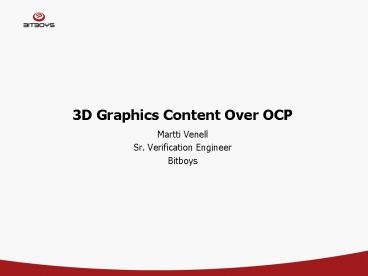3D Graphics Content Over OCP - PowerPoint PPT Presentation
1 / 13
Title:
3D Graphics Content Over OCP
Description:
CPU, memory and graphics bus form an own unity connected by the north bridge ... sets the performance upper limit for memory intensive scenes (e.g. blending) ... – PowerPoint PPT presentation
Number of Views:25
Avg rating:3.0/5.0
Title: 3D Graphics Content Over OCP
1
3D Graphics Content Over OCP
- Martti Venell
- Sr. Verification Engineer
- Bitboys
2
Mobile Graphics Trends
- Multimedia phone shipments with multimedia
accelerator
3
Graphics Architectures Traditionally
- CPU, memory and graphics bus form an own unity
connected by the north bridge - Graphics processor has dedicated memory
- Memory bandwidth hungry
4
Block Diagram of the Bus Interface
5
Key Features Pipeling
- Pipelining in the OCP Specification the return
of read data and the provision of write data may
be delayed after the presentation of the
associated request - Bus latencies can be compensated by sending
outstanding requests - Compensation of the bus latencies can be achieved
with - Intelligent pre-fetching mechanisms
- Smart caching
6
Key Features Byte Enables
- Transfers of less than a full word of data are
supported by providing byte enable information
that specifies which octets are to be
transferred. - When writing 256 bit burst to the color buffer
some pixels are wanted to stay as they were - Not supported by all bus protocols
- When writing 256-bit burst of the data, all
pixels may not be valid - With BE support full burst can be utilized
- Without BE support many different short writes
must be done
7
Key Features Threading
- Supports concurrency and out-of-order processing
of transfers - Multiple sources of memory accesses
- Gives an opportunity for different speed memory
fetches - Simplifies the design, because return data can be
identified with the ID
8
The SoC System From a 3D Graphics Point of View
- Three aspects memory bandwidth, system bus and
the graphics processor - Memory bandwidth sets the performance upper limit
for memory intensive scenes (e.g. blending). - Latency compensation drives the configuration of
the graphics core within the limits allowed by
the system bus. - Computational intensive (e.g. complicated
shading) scenes are limited to the graphics
processors pipeline efficiency and clock
frequency.
9
Systems Bus Architecture 1/2
- Limitations maximum burst size and the
availability of pipelining requests - Since the main memory accesses are targeted to
the external DRAM it makes sense to make long
burst accesses over the system bus - Various smart caching schemes are applied to make
sure that none of the system bandwidth goes to
waste - The availability of byte enables in the graphics
processors bus interface helps maximize the
burst size since there is no need to split
potential long bursts into smaller ones
10
Systems Bus Architecture 2/2
- The second issue is the memory latency of the
system which includes the total latency from the
graphics processor to the external memory and
back - One efficient way to compensate for this latency
is to send multiple outstanding requests to the
bus interface - By pipelining the requests in this way a
continuous data stream can be fed to the memory
bandwidth hungry graphics processor - Older bus interfaces, such as AMBA AHB 2.0, does
not support pipelining or byte enables.
11
Bus Interface Verification Environment
- Two verification environments (Arbiter/Master,
Input/Slave)
12
OCP Design and Verification Project Conclusions
- Good features
- Pipelining
- Byte enables
- Good parameterised approach
- Customer dependent configurations
- Only necessary features are implemented
- Simple to design and verify
- Cycle from customer requirements to design and
verification is short - Fewer bugs due to simplicity
13
Future Trends in Mobile Graphics Acceleration
- Display resolution sizes will be larger and of
higher quality - This is why graphics processor technology must be
scalable not to increase the memory bandwidth too
much when display resolutions increase - So called immediate mode rendering is used in
Bitboys' products and this will be the key issue
in terms of memory bandwidth - It is also very easy to scale the caches of the
graphics processor or the bus architecture - OCP 2.0 shows already good features, which are
needed in cutting edge multimedia technology































